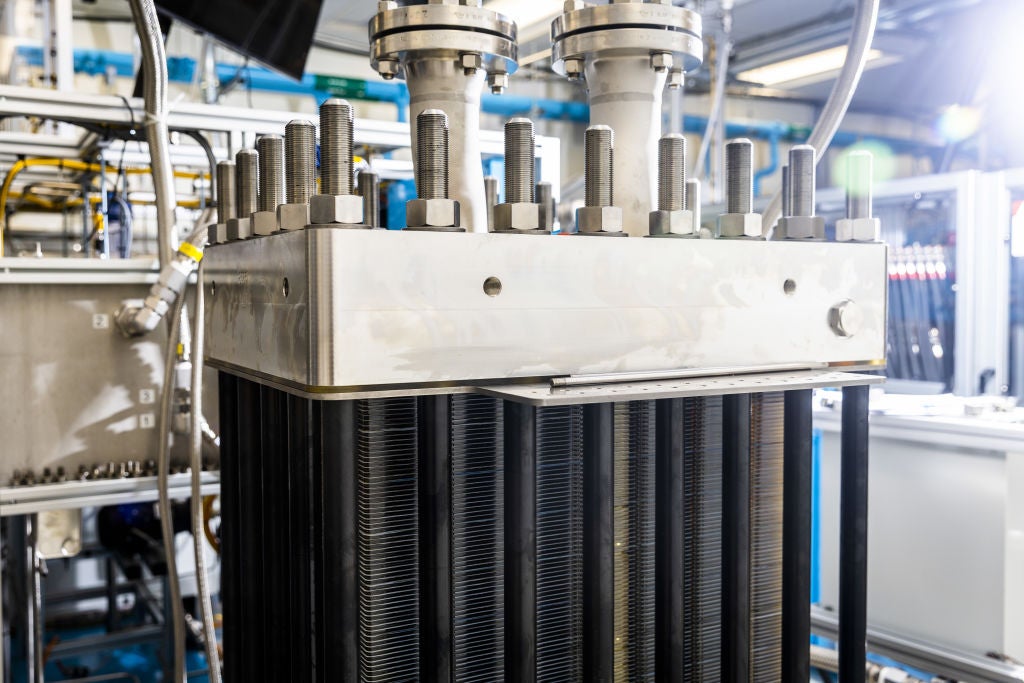Landmark federal legislation is now mobilising billions of dollars to energise a fledgling industry around green hydrogen, a carbon-free fuel and chemical feedstock that is produced with renewable energy. The good news is that green hydrogen is a versatile tool that can decarbonise industries ranging from marine shipping to steelmaking to fertiliser production. The caveat? The generous federal subsidies that are critical to rapidly scaling green hydrogen don’t yet dictate what the hydrogen is used for, which could result in projects that are financially viable for companies but aren’t in the best interest of the climate or consumers.
State and federal agencies have the power to ensure that public funding for green hydrogen doesn’t go towards building an energy bridge to nowhere. Instead, public agencies and regulators can guide green hydrogen towards the sectors where its use is both financially viable and where better alternatives aren’t already available. Staffers at the US Department of Energy (DOE), for example, can allocate funding from the Loan Programs Office and the Office of Clean Energy Demonstrations towards projects that decarbonise heavy industry and energy-intensive transport. State policymakers can develop road maps with a clear vision for where hydrogen will be used, then implement funding programmes and deployment targets to incentivise hydrogen fuel-switching in priority sectors.
Building a green hydrogen economy for today and tomorrow
Under last year’s Inflation Reduction Act (IRA), producers of green hydrogen can claim tax credits for the hydrogen they make, as well as for any new clean electricity that they generate to make that hydrogen. In some scenarios, the generous subsidies can make even inefficient uses of green hydrogen profitable. One prominent example is using power to produce hydrogen, then burning that hydrogen in a power plant to produce power again – wasting most of the energy along the way. While hydrogen may eventually play a role in decarbonising electricity, it will be as a store of energy for backup power to manage the variability of renewables, not as a primary source of baseload power.
Importantly, the federal subsidies are time-limited, so use cases that are marginally profitable today may be woefully uncompetitive down the line. Misguided investments in hydrogen uses like baseload power generation or home heating could leave utility customers on the hook for inefficient and expensive infrastructure that has only a short window of financial viability. Even with optimistic assumptions, for example, using hydrogen to heat homes will require at least three-times as much electricity as using a heat pump, and will be more expensive for consumers in the long run.
Getting our priorities straight
Fortunately, there are several priority industries that promise to be far better long-term customers for clean hydrogen producers. Sectors such as steelmaking and fertiliser production provide a more stable and lucrative market for green hydrogen, which offers a carbon-free alternative to coal, diesel and other polluting fossil fuels. Not only can green hydrogen fetch higher prices in those sectors, but it would also make a much bigger dent in global carbon emissions.
For example, analysis from the non-profit RMI finds that every kilogram (kg) of green hydrogen that displaces traditional fuels in the coal-heavy steel sector would prevent 33.6kg of CO2 from being emitted — more than five times the carbon savings of using hydrogen to generate power or heat buildings, where better decarbonisation technologies already exist.
Producing fertiliser from hydrogen instead of fossil gas would also provide substantial climate benefits, while boosting food security and insulating farmers from the volatility of fossil fuel prices. Similarly, deploying hydrogen-derived fuels such as ammonia and e-methanol in shipping and e-kerosene in aviation would enable widespread emissions reductions without limiting the scalability of these vital transport sectors.
Fuelling the US's clean industrial revolution
The US now has a once-in-a-lifetime opportunity to turbocharge the hydrogen economy – and ensure it is headed in the right direction. As part of the 2021 Bipartisan Infrastructure Law, the federal government is allocating $8bn to develop regional hydrogen hubs across the nation. These hubs will comprise clusters of interconnected hydrogen producers, consumers and transport infrastructure.
Regional coalitions looking to develop clean hydrogen hubs will submit their final applications to the DOE in April. The state agencies and private-sector players in these coalitions are eager to get in on the ground floor of this nascent industry, and their cost-sharing contributions will bring tens of billions of dollars to these regions. The hubs that are selected – and the industries within those hubs – will help determine whether green hydrogen reaches its economic and climate potential. Forthcoming guidance from the Treasury Department and the IRS that clarifies how the new IRA tax credits are implemented will also help shape the early hydrogen economy, given that these tax credits will spur potentially hundreds of billions of dollars in investment.
The boom in funding from IRA incentives, hydrogen hub investments and other initiatives gives the US a real opportunity to establish vibrant regional hydrogen hubs and clusters of clean industry. Alliances such as the Mission Possible Partnership, which helps align heavy industries and their customers behind decarbonisation solutions, can help grow these seeds into a nationwide hydrogen economy that transforms and modernises some of our highest-emitting industries. US policymakers have successfully summoned an unprecedented surge of interest and activity in carbon-free hydrogen. If they can channel it to the right sectors, they can help revitalise and decarbonise the nation’s industrial base at the same time.






